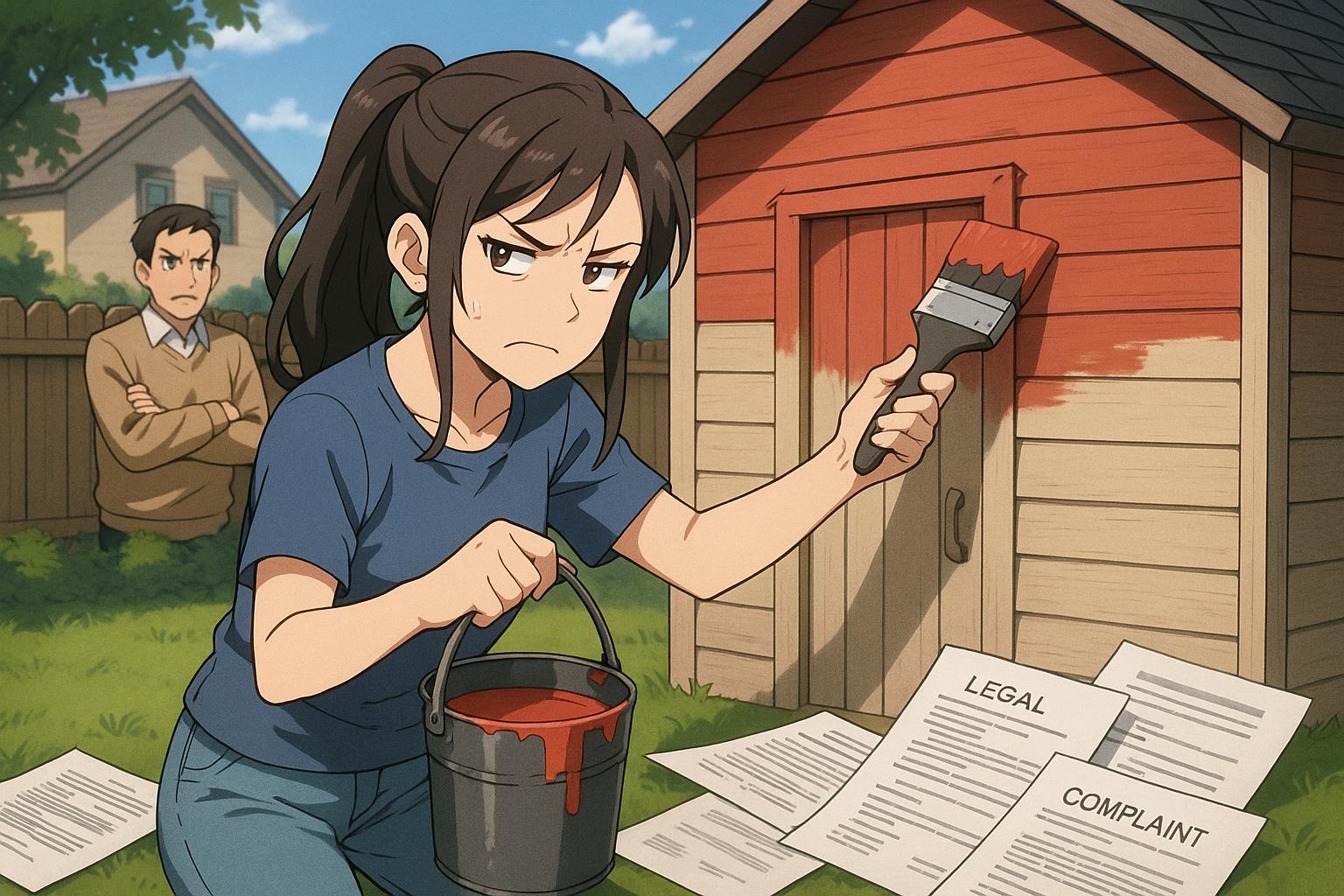Reality TV star Kate Lawler found herself in legal hot water after repainting a neighbour’s shed without consent, sparking a wider conversation about property rights and neighbourly respect.
In a recent incident highlighting the often tenuous relationship between homeowners and their neighbours, TV personality Kate Lawler disclosed on social media that she found herself in legal trouble after painting the back of a neighbouring shed—without consent. The 45-year-old, best known for winning the reality show Big Brother, shared her misadventures on Instagram, igniting a broader debate about neighbourly conduct and property rights.
Lawler’s gardener took it upon himself to repaint the shed because Lawler disapproved of its original colour. However, the move backfired when the neighbour expressed outrage, revealing that such an action, performed without permission, is considered trespassing—an unexpected revelation for Lawler, who admitted she was unaware of the legal implications. She explained, “I didn’t think it would be a big deal given that they can’t see it,” indicating a common misconception about property boundaries and ownership rights.
This anecdote touches on essential aspects of property law in the UK, where trespassing doesn’t merely involve entering another’s land; it encompasses any alteration or interference with someone else’s property, including the painting of structures. Legal sources indicate that trespassing can be a civil matter allowing property owners to seek remedies such as damages or injunctions. Notably, while the police typically do not intervene in such civil disputes, actions could escalate into criminal offences under certain circumstances, thus complicating the resolution.
Lawler’s predicament raises awareness around the need for clear communication and consent among neighbours. Guidance from legal experts suggests that property owners should always discuss plans that may involve shared spaces to prevent misunderstandings. For example, exploring whether a neighbour could paint a shared fence or shed should ideally be a collaborative decision, respecting each party’s rights and preferences.
In her follow-up post, Lawler sought to extract a lesson from her experience: “Don’t paint the back of someone’s shed without asking first because it is illegal.” This advice resonates with many who contribute to the online discourse surrounding such disputes. Many commenters empathised with her, stating they would not mind similar actions were they in her position, while others emphasised the importance of respecting property boundaries, highlighting the subjective nature of neighbourly relations.
Moreover, the incident echoes broader themes within community living, where small disputes can escalate if not addressed early. One article suggests documenting any instances of trespass and approaching your neighbour for a friendly discussion to mitigate conflicts. If amicable dialogue fails, property owners are encouraged to consider formal requests or legal advice to safeguard their interests.
Meanwhile, Lawler’s distress over the painting mishap was underscored by her humorous attempts to navigate another challenge—squeezing into a skin-tight SKIMS unitard, leading to a different yet equally entertaining Instagram moment. Her candidness about these encounters strikes a chord with her followers, not only providing comic relief but also fostering a sense of shared humanity in the trials of everyday life.
Ultimately, Lawler’s experience serves as a cautionary tale for homeowners about the legal nuances surrounding property modifications. The shared tales of neighbourly disputes remind us that while personal preferences may differ, mutual respect and communication remain vital for harmonious living. If anything, Lawler’s engagement with this issue encourages others to think twice before making alterations that could cross the invisible lines that define communal living.
Reference Map
- Paragraph 1: (1)
- Paragraph 2: (2), (3), (5)
- Paragraph 3: (4), (6)
- Paragraph 4: (1), (4)
- Paragraph 5: (2), (6)
- Paragraph 6: (1), (4)
- Paragraph 7: (6)
- Paragraph 8: (4)
Source: Noah Wire Services
- https://www.dailymail.co.uk/tvshowbiz/article-14728443/Kate-Lawler-reveals-shes-broken-law-locked-neighbour-dispute-garden-mishap-sparks-nationwide-debate.html?ns_mchannel=rss&ns_campaign=1490&ito=1490 – Please view link – unable to able to access data
- https://osborneslaw.com/property-law/property-litigation/trespass/ – This article from Osbornes Law explains the concept of trespassing in property law, detailing scenarios such as unauthorized entry, using private land as a shortcut, and encroaching across a boundary line. It clarifies that trespassing is a civil offence, allowing property owners to seek remedies like damages or injunctions. The piece also notes that while police typically don’t intervene in civil trespassing cases, certain actions like breaking and entering can be criminal offences, leading to fines or imprisonment.
- https://helix-law.co.uk/what-to-do-if-a-neighbour-trespasses-on-your-property/ – Helix Law provides guidance on addressing neighbour trespassing in the UK. The article outlines various actions that constitute trespass, including unauthorized entry and placing structures on another’s land. It discusses remedies available to landowners, such as obtaining an injunction or damages, and emphasizes the importance of prompt legal action. The piece also touches upon related issues like nuisance and party walls, advising property owners to seek legal advice to protect their interests.
- https://nuisanceneighbours.co.uk/boundary-battle-how-to-handle-trespassing-neighbours-in-your-garden/ – This article offers practical steps for dealing with trespassing neighbours in the UK. It suggests initiating a conversation with the neighbour, documenting incidents, and, if necessary, sending a formal letter requesting they refrain from entering your property. The piece also recommends installing physical barriers like fences, using signs to deter trespassing, and considering CCTV for evidence. If these measures fail, it advises seeking legal advice to address the issue effectively.
- https://nuisanceneighbours.co.uk/can-my-neighbour-paint-my-fence-what-are-your-rights/ – This article discusses the rights and legal considerations when a neighbour paints a fence in the UK. It emphasizes that, without explicit permission, a neighbour should not alter or paint your fence, as doing so could be considered trespassing or even vandalism. The piece advises property owners to communicate with their neighbours to reach mutual agreements before any work is done on shared property, highlighting the importance of respecting each other’s rights to avoid disputes.
- https://www.realhomes.com/news/real-homes-reports-how-you-could-be-unwittingly-committing-criminal-offences-in-your-garden – This article from Real Homes highlights potential criminal offences that gardeners might unknowingly commit. It warns against actions like painting a neighbour’s fence without permission, which could be considered vandalism. The piece advises gardeners to be mindful of their neighbours’ property rights and to seek permission before making alterations or improvements that could affect shared boundaries, emphasizing the importance of maintaining good neighbourly relations and avoiding legal issues.
- https://thebla.co.uk/trespassing-law-in-the-uk-guide-2024/ – The BLA provides a comprehensive guide to trespassing laws in the UK, detailing both civil and criminal trespassing. It explains that civil trespass allows property owners to seek remedies like injunctions and damages, while criminal trespass can lead to fines or imprisonment. The article also discusses defences against trespassing charges, such as lack of intent or implied permission, and outlines preventive measures property owners can take, including regular inspections and installing surveillance systems.
Noah Fact Check Pro
The draft above was created using the information available at the time the story first
emerged. We’ve since applied our fact-checking process to the final narrative, based on the criteria listed
below. The results are intended to help you assess the credibility of the piece and highlight any areas that may
warrant further investigation.
Freshness check
Score:
9
Notes:
The narrative refers to a recent personal experience shared by Kate Lawler on social media, specifically Instagram, indicating current relevance. There are no indications that the event is recycled news or referencing outdated information such as changed roles or deceased persons. The story appears original to the time of posting with no evidence of repetition from older articles.
Quotes check
Score:
8
Notes:
Direct quotes attributed to Kate Lawler originate from her own social media posts, presumably Instagram, which is a primary source. There is no evidence the quotes are taken from previous publications or secondary sources, indicating originality. However, exact timestamps or earliest online references to these quotes could not be independently verified beyond the social media context.
Source reliability
Score:
6
Notes:
The narrative originates from the Daily Mail, a widely known but tabloid-style UK publication. While it frequently covers celebrity and lifestyle news, its reputation for sensationalism affects its reliability score negatively. The Daily Mail is not considered as authoritative as outlets like BBC or Reuters, but it often provides accurate quotes and details in entertainment contexts.
Plausability check
Score:
9
Notes:
The claims about a neighbour dispute involving painting a shed without permission align with typical property law principles in the UK and common neighbourly conflicts. The legal context described is consistent with civic understanding of trespassing and property rights. The scenario is plausible and matches the kind of real-life incidents reported on social media by public figures.
Overall assessment
Verdict (FAIL, OPEN, PASS): PASS
Confidence (LOW, MEDIUM, HIGH): HIGH
Summary:
The narrative presents a fresh, plausible account reportedly originating from Kate Lawler’s own social media posts about a neighbour dispute, with direct quotes reflecting her perspective. Although the Daily Mail’s tabloid reputation moderates source reliability, the details are credible and consistent with known legal frameworks for property disputes. The story does not show signs of being recycled or outdated, and the quotes appear original, supporting a high confidence in the narrative’s factual integrity.













